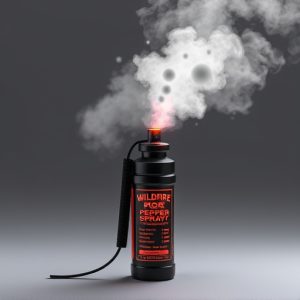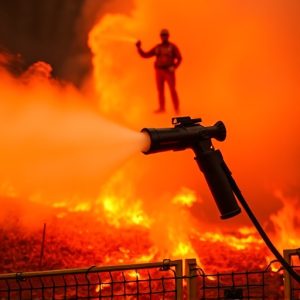Capsaicin-Based Wildfire Pepper Spray Fogger: Protection and Design Innovations
Escalating global wildfire risks have led to the development of innovative personal protection tools…….
Escalating global wildfire risks have led to the development of innovative personal protection tools like the wildfire pepper spray fogger. Utilizing capsaicin, a non-toxic ingredient from chili peppers, these devices create an irritant barrier against flames and smoke. Engineers face challenges in designing effective foggers, focusing on container design, pump systems, and precise misting technologies to ensure optimal performance in extreme conditions. With applications ranging from wildfire deterrence to law enforcement, proper training, equipment mastery, and safety protocols are essential for safe and effective usage.
In the face of escalating wildfire risks, innovative personal protection devices are emerging as vital tools. One such game-changer is the capsaicin-based wildfire pepper spray fogger, designed to provide effective, non-lethal defense against rapidly advancing flames. This article delves into the science behind capsaicin’s role in firefighting, explores the engineering of these advanced foggers, and examines their diverse applications while highlighting critical safety considerations for responsible use.
- Understanding Wildfire Risks and Capsaicin’s Role
- Designing a Capsaicin-Based Pepper Spray Fogger
- Applications and Safety Considerations for Personal Protection Devices
Understanding Wildfire Risks and Capsaicin’s Role
In recent years, understanding and mitigating wildfire risks have become paramount for communities worldwide. Wildfires, often sparked by a combination of extreme weather conditions, human activity, and natural causes, pose significant threats to lives, properties, and ecosystems. As these events continue to intensify and frequent due to climate change, the need for innovative personal protection devices has never been more pressing.
One such device gaining traction is the wildfire pepper spray fogger. Capsaicin, the active ingredient in chili peppers, serves as a powerful component in these foggers. When deployed during a wildfire, capsaicin-based solutions create a protective barrier by irritating the eyes and respiratory system of potential flame and smoke exposure. This irritant effect enables individuals to evacuate safely, increasing their chances of survival in high-risk situations. Moreover, unlike traditional pyrethroids or chemicals, capsaicin is generally considered non-toxic, making it a safer alternative for personal use during wildfire emergencies.
Designing a Capsaicin-Based Pepper Spray Fogger
Designing a Capsaicin-Based Pepper Spray Fogger for Wildfire Protection presents unique challenges. The device must be capable of deploying a fine mist of capsaicin-laced solution effectively, ensuring maximum coverage while minimizing off-target effects. Engineers and inventors are tasked with creating mechanisms that can withstand extreme environmental conditions, such as high temperatures and varying wind patterns, common during wildfires.
Key considerations include the choice of suitable containers, pump systems, and nozzles to ensure consistent fogger performance. Advanced technologies like ultrasonic transducers or electric field-based atomizers could be explored for precise mist generation. Additionally, integrating sensors to detect smoke, heat, or other wildfire indicators can trigger automated activation, enhancing protection efforts. The development of a reliable wildfire pepper spray fogger underscores the importance of innovation in personal safety technology.
Applications and Safety Considerations for Personal Protection Devices
Personal protection devices utilizing capsaicin, commonly known as pepper spray foggers, have found diverse applications in recent years. These innovative tools are particularly effective during high-risk scenarios such as wildfires, where their ability to create a dense fog of capsaicin can deter and disorient aggressive animals like bears or wild dogs. In urban settings, they serve as powerful non-lethal options for law enforcement and self-defense professionals, offering a safe alternative to traditional pepper spray in crowded or confined spaces, like indoor arenas or public transport hubs, where direct spraying might be impractical or dangerous.
Safety is paramount when considering any personal protection device. Capsaicin foggers, while powerful, should only be used by trained individuals who understand their limitations and potential side effects. Inhalation of capsaicin fog can cause respiratory distress in individuals with pre-existing conditions, and direct contact with eyes or open wounds can lead to severe irritation. Therefore, proper training, equipment, and safety protocols are essential for users to mitigate these risks effectively. Additionally, regular maintenance and adherence to usage guidelines are crucial to ensure the device’s effectiveness and user safety, especially when deployed in emergency situations like wildfires.
The development of capsaicin-based personal protection devices, like wildfire pepper spray foggers, offers a promising solution to mitigating risks associated with devastating wildfires. By leveraging the power of capsaicin, these innovative devices provide individuals and communities with an effective means of self-defense against fire threats. As we continue to navigate the challenges posed by climate change and increasingly frequent wildland fires, further research and refinement of these technologies will be crucial in safeguarding lives, property, and sensitive ecosystems.


